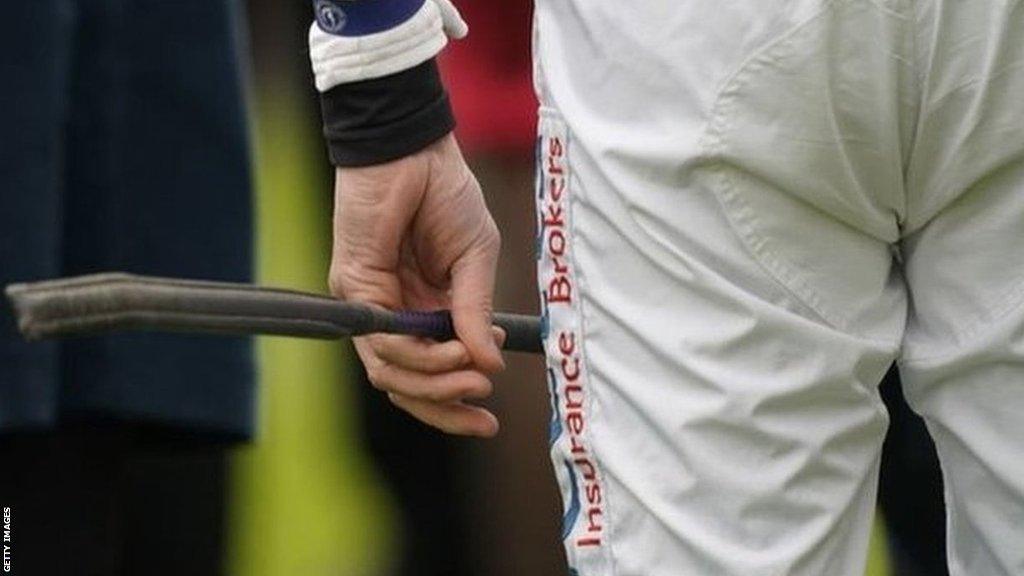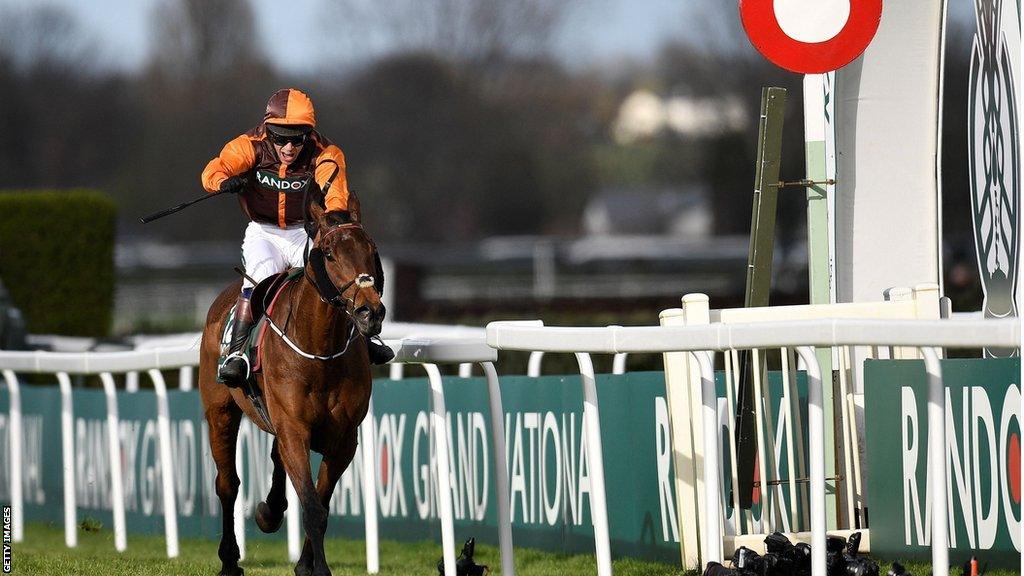Cheltenham Festival 2023: What are the new whip rules for jockeys?
- Published

New rules on use of the whip came into force last month
Controversial new whip rules have been introduced in British racing before the big Cheltenham Festival and Grand National meetings.
The changes mean horses face disqualification if there are serious breaches of the regulations.
So what is it all about and why have the rules caused such a stir?
What is the whip and why is it needed?
Modern whips used in racing have a polymer surround and are foam-padded and energy absorbing, meaning they are cushioned upon impact.
They are up to 70cm in length and weigh a maximum of 160 grams.
Manufacturers insist they do not cause pain to horses, although the Royal Society of the Protection of Animals (RSPCA) says there is evidence they do.
Supporters of the whip say it is a crucial tool for a rider, helping with safety and is intrinsic to the business of thoroughbreds competing against each other.
For safety, it can be used to get a horse's attention, keep it in a straight line or steer away from danger.
Opponents believe it should not be used for "encouraging" horses to run faster and that humans hitting animals is a bad look.
The British Horseracing Authority (BHA) says jockeys can use the whip to encourage horses to give their best or trigger a "gear change" but should not be used to coerce, for example with excessive force.
"A common misperception is that the whip is used to make the horse go faster. While it can sometimes generate an increase in speed, it is more about sustaining the horse's pace, particularly in the closing stages of a race," says the BHA.
What are the new rules?
Rules restricting the number of times the whip could be used in a race were introduced in 2011.
The recent changes, which began with a bedding-in period in January,were put forward after a public consultation and discussions by a steering group containing figures from across the racing industry.
The new rules reduce the number of times the whip is permitted by one - to seven in jumps races and six in flat races - and will be in place at a major meeting for the first time when jump racing's Cheltenham Festival starts on Tuesday.
Jockeys face suspension for going above that limit and their horse being disqualified if they go four or more over the threshold.
Bans are doubled if the offence takes place in Class 1 and 2 races.
Potential offences are now referred to a Whip Review Committee rather than being dealt with by racecourse stewards on the day.
The committee does not just focus on numbers.
It looks at the force used; whether it was used from above shoulder height; the time given for a horse to respond; the purpose of use; whether the horse was in contention or clearly winning; and whether the whip has been used in the correct place (for example, on the horse's hindquarter rather than flanks).
All bets by punters will stand on the day, with any breaches - and potential disqualifications - not dealt with until the following week.

Sam Waley-Cohen, in his final race as a jockey, was fined and given a suspension for breaching the old whip rules when winning the Grand National on Noble Yeats in April
How did we get here?
Racing's leaders do not believe use of a foam-padded whip is primarily a welfare issue, but accept there is a negative perception among some sections of the wider public.
A BHA review in 2011 concluded that "the whip stimulates a horse and should not cause pain", although the independently chaired Horse Welfare Board said four years ago that "scientific evidence relating to the welfare impacts of the whip remains inconclusive".
Despite criticism, the BHA ultimately hopes the new rules remove the whip as a subject of debate, particularly at big meetings, such as Cheltenham and Aintree's Grand National Festival in April, which it sees as a "shop window" for the sport that reaches beyond its core audience.
Julie Harrington, the BHA's chief executive, told an international racing industry conference in Australia this year that "we know the final stages of the (Cheltenham) Gold Cup will be shown on news programmes and that means this is an opportunity to make the sport look better."
The new rules also discourage riders from a win-at-all-costs attitude and jockeys feeling hard done by if they stay within the rules when a rival does not.
But some riders have struggled to adapt and believe policing of the changes has been draconian.
Irish jockeys who also compete in Britain have a different set of rules in their homeland, with eight strikes allowed, no disqualifications for whip breaches and stewards given greater discretion.
What has been the reaction?
The rules were introduced in British jump racing on 13 February after a bedding-in period which began at the start of January.
Twenty riders were suspended and one horse disqualified in the first week, although offences dropped in the subsequent two weeks.
Thirteen-time champion trainer Paul Nicholls said he was "livid" with the timing of the changes, so close to Cheltenham.
"We've got to stand up for ourselves and say, 'look, this is where we are, it's not a welfare issue,' he told Betfair.
"We need a bit of backbone. The BHA need a bit of backbone to stand up for us all the time instead of appeasing to the wrong people."
Harrington said the new rules were not introduced to appease people who "will never love the sport".
"What we're trying to do is make sure the sport is fair and that it's as attractive as possible to those people who don't have a strong opinion either way on the sport," she told Racing TV.
The World Horse Welfare charity, which was part of the consultation on the subject, said it supports use of the whip for safety but not for 'encouraging' horses to run faster.
Emma Slawinski, RSPCA director of policy, prevention and campaigns, said not banning the whip for encouragement was "a real missed opportunity for horse welfare".

Elon Musk's Twitter Storm: Find out how the new owner is transforming the company
Are eco laundry products better for the environment? Greg Foot investigates how such claims come out in the wash...
